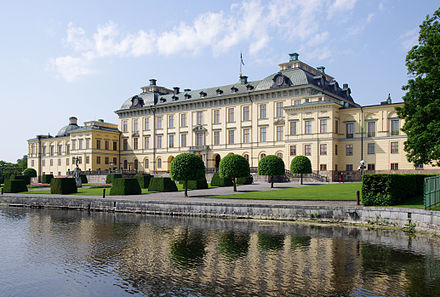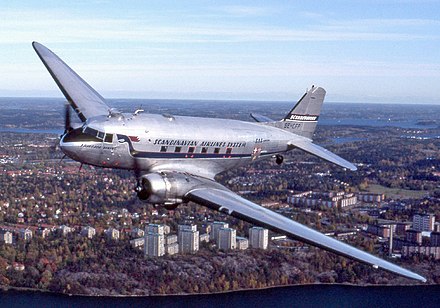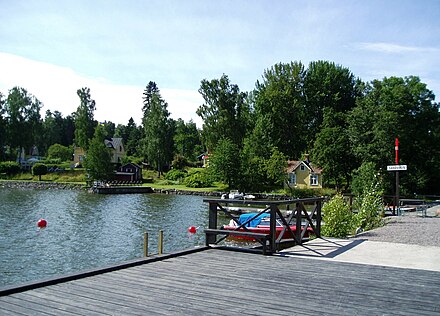Stockholm County - county in Sweden
Stockholm County (Stockholms län) in Sweden comprises the country's capital city, Stockholm, and its surrounding municipalities. With 2.3 million inhabitants, it is both the country's most populous region and the most densely populated one. Far from homogeneous, it includes dense urban areas as well as large expanses of forests and the Stockholm Archipelago, made up of more than 30,000 islands.
Stockholm dominates the area, and while most other municipalities are essentially suburbs, some of them have an identity on their own, notably Sweden's oldest city Sigtuna, the port of Nynäshamn, and the industrial hub of Södertälje.
Destinations
The county has 26 municipalities, not all of them of equal interest to tourists. For easier orientation, we group them into eight regions:

 Stockholm (municipalities of Stockholm, Solna, Sundbyberg, Lidingö and the town of Nacka in the namesake municipality)
Stockholm (municipalities of Stockholm, Solna, Sundbyberg, Lidingö and the town of Nacka in the namesake municipality)
Metropolitan Stockholm consists of Stockholm Municipality and some of the inner suburbs, containing five Royal Palaces, more than 80 museums and countless historical buildings, all within reach of public transport.
A freshwater archipelago, and the only Swedish municipality with two UNESCO World Heritage site: Drottningholm Palace, and Viking-age settlement Birka.
Stockholm Archipelago (many larger and smaller islands belonging to different municipalities, including Värmdö and Vaxholm. The island of Boo and the seaside resort of Saltsjöbaden in the Nacka municipality are also covered here)
Contains 30,000 islands spread across multiple municipalities, some with deep forests and wide farmlands, others only small rocks just reaching above the sea.
Södertörn (Botkyrka, Haninge, Huddinge, Nynäshamn, Salem and Tyresö)
A large island south of Stockholm, with lush forests, the Tyresta National Park, a long coastline, the port of Nynäshamn, and the world's largest IKEA store.
Södertälje (the municipalities of Södertälje and Nykvarn)
A major port, with a canal between the Baltic Sea and Lake Mälaren.
Stockholm's northern suburbs (Norrort) (Danderyd, Järfälla, Sollentuna, Täby, Upplands-Bro, Upplands Väsby and Vallentuna)
The outer suburbs of Stockholm are a good retreat for sport and outdoor life.
Sigtuna Municipality (Sigtuna, Märsta and Rosersberg, Stockholm-Arlanda Airport)
Sigtuna was founded in the 10th century, and was effectively Sweden's capital for 300 years.
The northernmost municipality, the most expansive in area and the most sparsely inhabited, offering a long coastline and many bodies of water surrounded by forests and farmlands, and therefore popular with tourists in summer.
Understand
Due to the post-glacial rebound, the land is rising. Until the 15th century, lake Mälaren was a bay of the Baltic Sea, and much of the land around Stockholm was beneath sea level. While Birka became Sweden's first city in the 8th century, Sigtuna was the cradle of the Swedish Kingdom. Stockholm was founded in the 13th century, and became the effective capital 200 years later.
Stockholm County was established in 1714 from parts of the Uppland and Södermanland provinces, not long after the county system was created in 1683. While most Swedish counties were formed by the provinces (landskap), each with their distinctive folk culture and local patriotism with roots in the Middle Ages, the identity of Stockholm County has emerged from the capital city. The city of Stockholm was an autonomous entity until it merged with the county in 1968; it contains 26 municipalities.
While the whole county is effectively suburbs of Stockholm today, towns such as Sigtuna, Vaxholm and Södertälje have their own interesting history.
Get in
The main hub of the county is the Stockholms Centralstation (Stockholm C or Centralen), which is the busiest station for long-distance and regional trains, local trains (underneath the metro station), the Stockholm metro (whose adjacent station is called T-Centralen) and airport, boat port and long-range buses (which stop at the adjacent Cityterminalen).

By plane
Stockholm county includes two major airports with scheduled passenger traffic:
- Stockholm Arlanda is the country's largest airport by far in terms of passenger traffic and the number of international and intercontinental connections. It has a railway station served by Storstockholms Lokaltrafik's local trains (pendeltåg), which can take you to all over the county (and even up to Uppsala County) either directly or with a transfer. There is also an express direct connection to Stockholm's central railway station called Arlanda Express, and bus connections locally within Sigtuna, to Uppsala and to Stockholm. See Stockholm Arlanda Airport for airport amenities, and Stockholm#Get in for transfer to central Stockholm.
- Stockholm Bromma is Stockholm's older airport, still within the city borders, now served mostly by domestic connections within Sweden.
- Stockholm Skavsta in Nyköping and Stockholm Västerås in Västerås also serve Stockholm, though they are each about 100 km away from the city. Most of the traffic consists of no-frills airlines.
By rail
The only train station in Stockholm served by long-distance domestic and international trains is the Centralstation, where you can change to local trains, the metro or a local bus further on to your destination. Some long-distance trains also call at Södertälje Syd, Flemingsberg, and Arlanda.
By bus
- Tapanis Buss has a route between Tornio, Finland and Stockholm serving coastal region along road E4
- FlixBus
By boat
Baltic sea ferries with passenger and vehicular (car and truck) capacities connect Stockholm with Helsinki, Turku, Riga and Tallinn. A ferry from Gdańsk arrives in Nynäshamn, a port in the south of Södertörn.

By road
Stockholm is served by three major motorways of the European motorway system:
- E4, which traverses the country from north to south, passes through Stockholm by way of the city's beltway. South of Stockholm, it goes across the country to its west coast, terminating in Helsingborg (where you can branch out further south to Malmö and Copenhagen), passing by Nyköping, Linköping and Jönköping. In Jönköping, you can branch out to Gothenburg. North of Stockholm, the E4 follows the Baltic Sea coast to major Norrland seaside cities like Umeå, Luleå and Skellefteå and ends in Finland.
- E18, which leads by ferry from Finland to Norrtälje and goes north of the lake Mälaren through Västerås, Örebro and Karlstad to the Norwegian border and then on to Oslo
- E20, which goes south from Stockholm via Södertälje, and then, south of lake Mälaren, it goes west to Gothenburg. In Gothenburg, it turns south along the North Sea coast to Malmö.
Entering Stockholm by car incurs a congestion charge; see also Stockholm#By car.

Get around
By car
Though public transport serves nearly all settlements in the county, driving can be a practical option for the countryside. Some archipelago islands are connected to the mainland by car ferries. Tourist destinations can be congested around holidays.
The north-south divide in Stockholm (between Södermalm and the northern boroughs) is a chokepoint during rush hour.
Despite the size of Stockholm, much of the outer county is wild nature. Even a few kilometres outside built-up areas, traffic lighting is scarce, and animal collisions become a concern.
Passage through inner Stockholm is subject to a congestion tax; see Stockholm#By car for details.
Public transit
See also: Public transport in Stockholm County
Storstockholms Lokaltrafik AB, SL provides public transportation across the county. This includes light rail, metro, trains and bus lines. There are also regular ferries between the islands which are operated by independent companies - some are under the same SL fare scheme, and others are not, requiring separate tickets.
Some lines extend to Uppsala, Gnesta and Bålsta for an extra fee (see below).

The SL website has detailed ticket and price information in English, and a journey planner. It is always updated.
Tickets
.jpg/440px-Ticket_machine_-_2008-02-07_(gabbe).jpg) SL tickets can be bought at the public transport centers (in stations, including Central station and the T-Central), at all Pressbyrån stores, major grocery stores and some smaller kiosks. They can also be bought at the Arlanda visitor center at the airport. Stockholm operates a RFID card called SL Access which triggers entry gates and other electronic readers.
SL tickets can be bought at the public transport centers (in stations, including Central station and the T-Central), at all Pressbyrån stores, major grocery stores and some smaller kiosks. They can also be bought at the Arlanda visitor center at the airport. Stockholm operates a RFID card called SL Access which triggers entry gates and other electronic readers.
There are two forms of ticketing, period passes and single tickets.
All travel cards can be loaded onto the SL access card. 24-hour and 72-hour travel cards are additionally available as individual disposable paper RFID tickets. A VISA or a Mastercard can be used as an adult single ticket.
Tickets are checked upon entering a ticket gate, or boarding a bus. They must be carried throughout the journey for random inspections.
Airport buses, Arlanda Express and regional trains are not part of the SL network, and thus not included in any of these tickets. However, SL does operate certain local buses to Arlanda (582, 583, 592, 593, the latter two only running overnight) on which SL tickets are valid.
Stockholm Metro

The SL website has a guidebook to the artwork that is featured in many metro stations, with nearly all stations offering some form of artwork on display. The art on the blue line in particular is of note.
Commuter rail
Stockholm County has a commuter rail network, pendeltåg, reaching 53 stations, including Uppsala, Knivsta and Bålsta in Uppsala county, plus Gnesta in Södermanland county. Stations are marked by a J sign. There are four lines:
- 35: (Bålsta) - Kungsängen - Stockholm C - Västerhaninge - (Nynäshamn)
- 36: Märsta - Stockholm C - Södertälje C
- 37: Södertälje C - Gnesta (connects with line 36 at Södertälje hamn)
- 38: Uppsala - Arlanda Airport - Stockholm C - Älvsjö - (Tumba).
Commuter trains are included in Stockholm's transport ticket system, with the exception of Knivsta and Uppsala on line 38, which employ Uppsala's local transport fares, and Arlanda Airport (see #By plane above).
As of 2019, some escalators of stations Stockholm City and Odenplan are closed down. While every passage has at least one pair of escalators, passengers need to line up at rush hours.
Light rail/tram
 Stockholm county has four light rail lines, with modern trams.
Stockholm county has four light rail lines, with modern trams.
- Tvärbanan connecting Västerort to Söderort.
- Lidingöbanan connects Ropsten in Östermalm to Lidingö. Several archipelago ferries call at Gåshaga brygga at the end of the line.
- Nockebybanan in Västerort connects the district of Nockeby to Alvik on the green line of the Tunnelbana.
- Spårväg City is a city tram connecting Stockholm Central to Waldemarsudde (Djurgården). Occasional heritage trams.
Buses
Buses serve most populated areas where metro, rail or tram does not reach. Four inner city main lines numbered from 1 to 4 are operated by large blue buses (weekdays every 3–10 minutes), the other, generally less frequent lines (weekdays 7–20 minutes), by red buses.
Apart from those four, several lines running through outer districts and suburbs of Stockholm are designated as blue buses - apart from the colour, they are distinguished by the middle 7 in their three-digit line number. The three-digit blue buses do not go to the city center and generally serve as radial lines to quickly link various areas of a suburban community with its main rail transit nodes.
Passenger ferries
There are also ferries going to Djurgården and Skeppsholmen, and from Nybroplan to Nacka and Lidingö.
By taxi
Smartphone apps:
- Uber
See
As Stockholm has been the nation's capital for centuries, it is packed with museums, palaces, art galleries and other attractions — the Royal Palace, the Skansen outdoor museum and the Vasa Museum, to mention a few. The outskirts of the county have impressive natural features, as well as a rich cultural heritage.
- The Stockholm Archipelago is both a tranquil refuge and home to quite a few historic monuments and museums scattered across the islands - just getting there over the water provides for some spectacular sights
- Ekerö contains the Drottningholm Palace, the residence of the Royal family, as well as Viking Age settlement Birka
- Sigtuna is Sweden's oldest continually existing city, and holds many artefacts thereof
- Tumba and Huddinge in Södertörn have museums devoted to their natural heritage

Do
The city of Stockholm contains many sports and entertainment venues including the humongous Globen and Friends Arena, and there is always something major happening to be experienced live.
Though the county is the most populous of Sweden, most of its area consists of nature, with many opportunities for outdoor life, even within less than an hour of commuting from Stockholm.
The county has a very long coastline and includes vast expanses of water, which lends itself to all kinds of activities, from water sport to simply sunbathing or picnicking on one of the many sea- and lakeshores. Surprisingly for localities easily reachable by commuter railway, you do not have to get far out of Stockholm either to observe wildlife up close and engage in a Nordic photo safari.
Eat
There is not much in the way of a particular cuisine of Stockholm County. Seafood is prevalent, and local catch is usually available. You will of course be able to enjoy favourites and specialties from all of Sweden, and fine dining. Due to the region's diverse ethnic makeup, you may also take advantage of the wide range of non-Swedish cuisines represented throughout the county, in particular Middle Eastern cuisine (including kebab and falafel stands) and Thai cuisine, as well as high-end specialty restaurants.
Drink
Central Stockholm (Östermalm, Norrmalm, Gamla stan and Södermalm) obviously has the liveliest nightlife, and given the great public transportation connections, the inhabitants of other municipalities tend to go there to party and enjoy evenings out as well.
Sleep
Given the well-developed public transport network, as well as the distribution of major businesses and venues throughout the county, you are not limited to Stockholm itself in your search for accommodation. Most accommodation in central Stockholm are business hotels and priced accordingly; expect to pay at least 1000 kr for a 4-star single room. Stockholm has many hostels with dorm beds at around 200 kr a night, which tend to be sold out at summer.
Therefore, you may want to look for a better deal in one of the other municipalities - provided you can figure out good connections from the place you stay to where you want to get. The outer areas also have mansion and palace hotels in the countryside.
The outskirts of the country feature many campsites, and the Right to roam allows overnight camping at most locations.
Stay safe
Stockholm is generally a safe city, at least for visitors who use common sense. While some low-income suburbs are infamous for gang crime, daytime visitors would not be troubled. In Stockholm itself, drunk brawls and pick pocketing are major risks.
Go next
- Uppsala County contains Uppsala, a university city and seat of the Church of Sweden, as well as Enköping.
- Södermanland County has many lakes, and quaint towns such as Mariefred, Eskilstuna and Nyköping.
- Åland is a Swedish-speaking island associated with Finland.